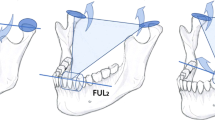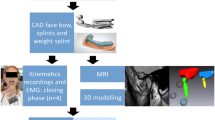Abstract
It is well established that subjects without molars have reduced ability to comminute foods. However, epidemiological studies have indicated that the masticatory system is able to functionally adapt to the absence of posterior teeth. This supports the shortened dental arch concept which, as a prosthetic option, recommends no replacement of missing molars. Biomechanical modeling, however, indicates that using more anterior teeth will result in a larger temporomandibular joint load per unit of bite force. In contrast, changing bite from incisor to molar position increases the maximum possible bite force and reduces joint loads. There have been few attempts, however, to determine realistic joint loads and corresponding muscular effort during generation of occlusal forces similar to those used during chewing with intact or shortened dental arches. Therefore, joint and cumulative muscle loads generated by vertical bite forces of submaximum magnitude moving from canine to molar region, were calculated. Calculations were based on intraoral measurement of the feedback-controlled resultant bite force, simultaneous electromyograms, individual geometrical data of the skull, lines of action, and physiological cross-sectional areas of all jaw muscles. Compared to premolar and canine biting, bilateral and unilateral molar bites reduced cumulative muscle and joint loads in a range from 14% to 33% and 25% to 53%, respectively. During unilateral molar bites, the ipsilateral joints and contralateral muscles were about 20% less loaded than the opposing ones. In conclusion, unilateral or bilateral molar biting at chewing-like force ranges caused the least muscle and joint loading.






Similar content being viewed by others
References
Kayser AF (1981) Shortened dental arches and oral function. J Oral Rehabil 8:457–462
van der Bilt A, Olthoff LW, Bosman F, Oosterhaven SP (1993) The effect of missing postcanine teeth on chewing performance in man. Arch Oral Biol 38:423–429
van der Bilt A, Olthoff LW, Bosman F, Oosterhaven SP (1994) Chewing performance before and after rehabilitation of post-canine teeth in man. J Dent Res 73:1677–1683
Sarita PT, Witter DJ, Kreulen CM, Van't Hof MA, Creugers NH (2003) Chewing ability of subjects with shortened dental arches. Community Dent Oral Epidemiol 31:328–334
Sarita PT, Kreulen CM, Witter D, Creugers NH (2003) Signs and symptoms associated with TMD in adults with shortened dental arches. Int J Prosthodont 16:265–270
Mansour RM, Reynik RJ (1975) In vivo occlusal forces and moments: I. Forces measured in terminal hinge position and associated moments. J Dent Res 54:114–120
Greaves WS (1983) A functional analysis of carnassial biting. Biol J Linn Soc 20:353–363
Osborn JW, Baragar FA (1985) Predicted pattern of human muscle activity during clenching derived from computer assisted model: symmetric vertical bite forces. J Biomech 18:599–612
Hatcher DC, Faulkner MG, Hay A (1986) Development of mechanical and mathematic models to study temporomandibular joint loading. J Prosthet Dent 55:377–384
Koolstra JH, van Eijden TM, Weijs WA, Naeije M (1988) A three-dimensional mathematical model of the human masticatory system predicting maximum possible bite forces. J Biomech 21:563–576
van Eijden TM (1991) Three-dimensional analyses of human bite-force magnitude and moment. Arch Oral Biol 36:535–539
Van Eijden TM (1990) Jaw muscle activity in relation to the direction and point of application of bite force. J Dent Res 69:901–905
Hattori Y, Satoh C, Seki S, Watanabe Y, Ogino Y, Watanabe M (2003) Occlusal and TMJ loads in subjects with experimentally shortened dental arches. J Dent Res 82:532–536
Pröschel PA, Jamal T, Morneburg TR (2008) Motor control of jaw muscles in chewing and in isometric biting with graded narrowing of jaw gape. J Oral Rehabil 35:722–728, Epub 2008 May 2009
Barbenel JC (1972) The biomechanics of the temporomandibular joint: a theoretical study. J Biomech 5:251–256
Throckmorton GS (1985) Quantitative calculations of temporomandibular joint reaction forces–II. The importance of the direction of the jaw muscle forces. J Biomech 18:453–461
Throckmorton GS, Throckmorton LS (1985) Quantitative calculations of temporomandibular joint reaction forces–I. The importance of the magnitude of the jaw muscle forces. J Biomech 18:445–452
Koolstra JH, van Eijden TM (1992) Application and validation of a three-dimensional mathematical model of the human masticatory system in vivo. J Biomech 25:175–187
Osborn JW (1995) Biomechanical implications of lateral pterygoid contribution to biting and jaw opening in humans. Arch Oral Biol 40:1099–1108
Iwasaki LR, Thornton BR, McCall WD Jr, Nickel JC (2004) Individual variations in numerically modeled human muscle and temporomandibular joint forces during static biting. J Orofac Pain 18:235–245
Pruim GJ, de Jongh HJ, ten Bosch JJ (1980) Forces acting on the mandible during bilateral static bite at different bite force levels. J Biomech 13:755–763
Nickel JC, Iwasaki LR, Walker RD, McLachlan KR, McCall WD Jr (2003) Human masticatory muscle forces during static biting. J Dent Res 82:212–217
Schindler HJ, Rues S, Türp JC, Schweizerhof K, Lenz J (2007) Jaw clenching: muscle and joint forces, optimization strategies. J Dent Res 86:843–847
Anderson DJ, Picton DCA (1958) Masticatory stresses in normal and modified occlusion. J Dent Res 37:312–317
Schindler HJ, Stengel E, Spiess WE (1998) Feedback control during mastication of solid food textures—a clinical-experimental study. J Prosthet Dent 80:330–336
Morneburg TR, Pröschel PA (2003) In vivo forces on implants influenced by occlusal scheme and food consistency. Int J Prosthodont 16:481–486
Rues S, Schindler HJ, Türp JC, Schweizerhof K, Lenz J (2008) Motor behavior of the jaw muscles during different clenching levels. Eur J Oral Sci 116:223–228
Rues S, Lenz J, Türp JC, Schweizerhof K, Schindler HJ (2008) Forces and motor control mechanisms during biting in a realistically balanced experimental occlusion. Arch Oral Biol 53:1119–1128
Schindler HJ, Rues S, Türp JC, Schweizerhof K, Lenz J (2005) Activity patterns of the masticatory muscles during feedback-controlled simulated clenching activities. Eur J Oral Sci 113:469–478
Hems T, Tillmann B (2000) Tendon entheses of the human masticatory muscles. Anat Embryol (Berl) 202:201–208
Van Eijden TM, Korfage JA, Brugman P (1997) Architecture of the human jaw-closing and jaw-opening muscles. Anat Rec 248:464–474
Van Eijden TM, Klok EM, Weijs WA, Koolstra JH (1988) Mechanical capabilities of the human jaw muscles studied with a mathematical model. Arch Oral Biol 33:819–826
Throckmorton GS, Groshan GJ, Boyd SB (1990) Muscle activity patterns and control of temporomandibular joint loads. J Prosthet Dent 63:685–695
Blanksma NG, van Eijden TM (1995) Electromyographic heterogeneity in the human temporalis and masseter muscles during static biting, open/close excursions, and chewing. J Dent Res 74:1318–1327
Murray GM, Phanachet I, Klineberg IJ (1999) Electromyographic evidence for functional heterogeneity in the inferior head of the human lateral pterygoid muscle: a preliminary multi-unit study. Clin Neurophysiol 110:944–950
Throckmorton GS (1989) Sensitivity of temporomandibular joint force calculations to errors in muscle force measurements. J Biomech 22:455–468
Miles TS (2004) Mastication. In: Miles TS, Nauntofte B, Svensson P (eds) Clinical oral physiology. Quintessence, Copenhagen, pp 219–243
Trulsson M, Essick GK (2004) Mechanosensation. In: Miles TS, Nauntofte B, Svensson P (eds) Clinical oral physiology. Quintessence, Copenhagen, pp 165–196
Morimoto T, Hikada O, Komuro A, Inoue T, Nagashima T (1999) Contribution of jaw muscle spindles to the control of mastication. In: Nakamura Y, Sessle BJ (eds) Neurobiology of mastikation. Elsevier, Amsterdam, pp 201–212
Shinogaya T, Tanaka Y, Toda S, Hayakawa I (2002) A new approach to evaluating occlusal support by analyzing the center of the bite force. Clin Oral Investig 6:249–256
Hattori Y, Satoh C, Kunieda T, Endoh R, Hisamatsu H, Watanabe M (2009) Bite forces and their resultants during forceful intercuspal clenching in humans. J Biomech 42:1533–1538
Acknowledgments
This investigation was supported by the Deutsche Forschungsgemeinschaft by grants SCHW 307/15-1 and STRU 675/1-1.
Conflict of interest
The authors declare that they have no conflict of interest.
Author information
Authors and Affiliations
Corresponding author
Appendix
Appendix
Mathematical method
Force law
Muscle forces were specified according to the law \( {\overrightarrow F_i} = P \cdot {A_i} \cdot \cos {\alpha_i}\{ c\;{U_{rel,i}} + (1 - c)\;U_{rel,i}^2\} {\overrightarrow e_i} \) \( ({\overrightarrow F_{\max, i}} = P \cdot {A_i} \cdot \cos {\alpha_i}{\overrightarrow e_i}) \). This equation extends the previously used law \( {\overrightarrow F_i} = P \cdot {A_i} \cdot U_{\hbox{rel,i}}\;{\overrightarrow e_i} \) [21] by a correction factor for the pennation angle αi (for α ≤ 15°:0.97 ≤ cosα ≤ 1) and parameter c characterizing the degree of nonlinearity between the muscle force and the relative electric muscle activity U rel. This approach fulfills the following boundary conditions:
-
1.
Fi(Urel = 0)/Fmax,i = 0 (no electric activation corresponds to zero muscle force)
-
2.
\( {F_i}\left( {{U_{\rm{rel}}} = {1}} \right)/{F_{{ \max },i}} = c + \left( {{1} - c} \right) = {1} \) (maximum muscle force at maximum activation)
Determination of parameters P and c
Due to model assumptions and measurement errors it cannot be expected that the balance of momentum of the muscle forces \( \overrightarrow F_i \) and bite forces \( \overrightarrow B_i\) with respect to the intercondylar axis (y-axis), to which the joint forces do not contribute, will be satisfied exactly. The torques of these forces with respect to the y-axis will rather sum up to a resulting error torque ΔMy ≠ 0. In order to satisfy the balance of momentum exactly and, in addition, to gain an individual constant parameter set (P,c) for each subject (physiological properties of the muscles do not change under natural conditions for the individual subject), the following two-stage procedure was accomplished: In a first step, on the basis of 36 clenching tasks with bite force magnitudes ranging from 50 to 400 N, the best parameter set (P,c)opt, for which the objective function \( f\left( {P,c} \right) = {\sum\limits_{n = 1}^{36} {\left( {\Delta My,n/F{\hbox{res}},n} \right)}^2} \) with \( {F_{{\rm{res}},n}} = \left| {\sum\limits_{j = 1}^3 {{{\overrightarrow B }_{j,n}}} } \right| \) reached a minimum value (minimization of the squared relative error torques), was computed via optimization. With the force law F i = f(P,c,U rel,i ), all muscle forces would then be given by the measured EMG activities of the masticatory muscles. However, even for this optimal constant parameter set (P,c)opt small error torques remain.
Principally, for the second step, two possibilities exist to continue:
-
1.
Accepting small error torques ΔMy due to inevitable (presumably minor) errors in measurement and/or assumptions, which are present even for the best parameter set. The advantage of this choice is that P opt and c opt are kept constant; the disadvantage is that no (exact) equilibrium can be achieved, i.e., the computed forces cannot represent the exact distribution of joint and muscle forces which balance the clenching forces.
-
2.
Exactly fulfilling the equilibrium conditions by varying the parameter P (P var), i.e., not using the constant P opt computed by the optimization. The advantage of this approach is that the computed force distribution represents muscle and joint forces exactly balancing the bite forces. The disadvantage of this method is that P is variable. In the present work, option (2) was chosen. For c, the value of copt was maintained (Table 3).
Table 3 Equations used for the calculation of muscle and joint forces and footnote with used abbreviations
Rights and permissions
About this article
Cite this article
Rues, S., Lenz, J., Türp, J.C. et al. Muscle and joint forces under variable equilibrium states of the mandible. Clin Oral Invest 15, 737–747 (2011). https://doi.org/10.1007/s00784-010-0436-4
Received:
Accepted:
Published:
Issue Date:
DOI: https://doi.org/10.1007/s00784-010-0436-4




